The Growth Promotion of Peppers (Capsicum annuum L.) by Trichoderma guizhouense NJAU4742-Based Biological Organic Fertilizer: Possible Role of Increasing Nutrient Availabilities
Abstract
1. Introduction
2. Materials and Methods
2.1. Preparation of T. guizhouense NJAU4742-Based Solid Microbial Spawn and Biological Organic Fertilizer
2.2. Soil Collection and Greenhouse Pot Experiment
2.3. Determinations of Pepper Biomass and the Soil’s Physicochemical Properties
2.4. Quantitative Estimation of Different Culturable Microorganisms
2.5. Soil Total DNA Extraction and Quantitative Determinations of Different Microorganisms via Fluorescence
2.6. Soil Enzyme Activity Determinations
2.7. Statistical Analysis
3. Results
3.1. Preparation of Solid Spawn and T. guizhouense NJAU4742-Based Biological Organic Fertilizer
3.2. Effects of Solid Spawn and T. guizhouense NJAU4742-Based BOF on Pepper Growth
3.3. Determination of Soil Enzyme Activities
3.4. Contents of Total Nitrogen, Soil Organic Carbon and Available Phosphorus in Soil
3.5. Correlation Analyses of Soil Physiochemical Properties, Soil Enzyme Activity and Pepper Yield
3.6. Quantification of Rhizosphere Microorganisms
4. Discussion
4.1. Pepper Growth Promotion by NJAU4742-Based Biological Organic Fertilizer
4.2. Soil Enzyme Activity and Nutrient Availability
4.3. Soil Microbial Diversity
5. Conclusions
Supplementary Materials
Author Contributions
Funding
Acknowledgments
Conflicts of Interest
References
- Sharma, S.; Kour, D.; Rana, K.L.; Dhiman, A.; Thakur, S.; Thakur, P.; Thakur, S.; Thakur, N.; Sudheer, S.; Yadav, N. Trichoderma: Biodiversity, ecological significances, and industrial applications. In Recent Advancement in White Biotechnology through Fungi; Springer: Berlin/Heidelberg, Germany, 2019; pp. 85–120. [Google Scholar] [CrossRef]
- Meena, M.; Swapnil, P. Regulation of WRKY genes in plant defence with beneficial fungus Trichoderma: Current perspectives and future prospects. Arch. Phytopathol. Pflanzenschutz. 2019, 52, 1–17. [Google Scholar] [CrossRef]
- Gupta, R.; Bar, M. Plant immunity, priming, and systemic resistance as mechanisms for Trichoderma spp. biocontrol. In Trichoderma; Springer: Berlin/Heidelberg, Germany, 2020; pp. 81–110. [Google Scholar]
- Viterbo, A.; Landau, U.; Kim, S.; Chernin, L.; Chet, I. Characterization of ACC deaminase from the biocontrol and plant growth-promoting agent Trichoderma asperellum T203. FEMS Microbiol. Lett. 2010, 305, 42–48. [Google Scholar] [CrossRef] [PubMed]
- Bhattacharyya, P.N.; Jha, D.K. Plant growth-promoting rhizobacteria (PGPR): Emergence in agriculture. World J. Microbiol. Biotechnol. 2012, 28, 1327–1350. [Google Scholar] [CrossRef] [PubMed]
- de Graaff, M.-A.; Hornslein, N.; Throop, H.L.; Kardol, P.; van Diepen, L.T.A. Chapter one—Effects of agricultural intensification on soil biodiversity and implications for ecosystem functioning: A meta-analysis. Adv. Agron. 2019, 155, 1–44. [Google Scholar] [CrossRef]
- Jannoura, R.; Joergensen, R.G.; Bruns, C. Organic fertilizer effects on growth, crop yield, and soil microbial biomass indices in sole and intercropped peas and oats under organic farming conditions. Eur. J Agron. 2014, 52, 259–270. [Google Scholar] [CrossRef]
- Qiu, M.; Zhang, R.; Xue, C.; Zhang, S.; Li, S.; Zhang, N.; Shen, Q. Application of bio-organic fertilizer can control Fusarium wilt of cucumber plants by regulating microbial community of rhizosphere soil. Biol. Fertil. Soils. 2012, 48, 807–816. [Google Scholar] [CrossRef]
- Martínez-Medina, A.; Alguacil, M.; Pascual, J.; Wees, S. Phytohormone profiles induced by Trichoderma isolates correspond with their biocontrol and plant growth-promoting activity on melon plants. J. Chem. Ecol. 2014, 40, 804–815. [Google Scholar] [CrossRef]
- Shivanna, M.B.; Meera, M.S.; Hyakumachi, M. Sterile fungi from zoysiagrass rhizosphere as plant growth promoters in spring wheat. Can. J. Microbiol. 1994, 40, 637–644. [Google Scholar] [CrossRef]
- Arshad, M.; Frankenberger, W.T., Jr. Plant growth-regulating substances in the rhizosphere: Microbial production and functions. In Advances in Agronomy; Academic Press: Cambridge, MA, USA, 1997; Volume 62, pp. 45–151. [Google Scholar] [CrossRef]
- Kumar, B.S.D. Fusarial wilt suppression and crop improvement through two rhizobacterial strains in chick pea growing in soils infested with Fusarium oxysporum f.sp. ciceris. Biol. Fertil. Soils. 1999, 29, 87–91. [Google Scholar] [CrossRef]
- Li, R.-X.; Cai, F.; Pang, G.; Shen, Q.-R.; Li, R.; Chen, W. Solubilisation of phosphate and micronutrients by Trichoderma harzianum and its relationship with the promotion of tomato plant growth. PLoS ONE 2015, 10, e0130081. [Google Scholar] [CrossRef]
- Halifu, S.; Deng, X.; Song, X.; Ruiqing, S. Effects of two Trichoderma strains on plant growth, rhizosphere soil nutrients, and fungal community of Pinus sylvestris var. mongolica annual seedlings. Forests 2019, 10, 758. [Google Scholar] [CrossRef]
- de Santiago, A.; Quintero, J.; Aviles, M.; Delgado, A. Effect of Trichoderma asperellum strain T34 on iron, copper, manganese, and zinc uptake by wheat grown on a calcareous medium. Plant Soil 2010, 342, 97–104. [Google Scholar] [CrossRef]
- Kloepper, J.W.; Leong, J.; Teintze, M.; Schroth, M.N. Enhanced plant growth by siderophores produced by plant growth-promoting rhizobacteria. Nature 1980, 286, 885–886. [Google Scholar] [CrossRef]
- Sinsabaugh, R.L.; Gallo, M.E.; Lauber, C.; Waldrop, M.P.; Zak, D.R. Extracellular enzyme activities and soil organic matter dynamics for Northern Hardwood Forests receiving simulated nitrogen deposition. Biogeochemistry 2005, 75, 201–215. [Google Scholar] [CrossRef]
- Wu, S.C.; Cao, Z.H.; Li, Z.G.; Cheung, K.C.; Wong, M.H. Effects of biofertilizer containing N-fixer, P and K solubilizers and AM fungi on maize growth: A greenhouse trial. Geoderma 2005, 125, 155–166. [Google Scholar] [CrossRef]
- Morrissey, E.M.; Berrier, D.J.; Neubauer, S.C.; Franklin, R.B. Using microbial communities and extracellular enzymes to link soil organic matter characteristics to greenhouse gas production in a tidal freshwater wetland. Biogeochemistry 2014, 117, 473–490. [Google Scholar] [CrossRef]
- Wang, J.L.; Liu, Z.M.; Wang, Y.; Cheng, W.; Mou, H.J. Production of a water-soluble fertilizer containing amino acids by solid-state fermentation of soybean meal and evaluation of its efficacy on the rapeseed growth. J. Biotechnol. 2014, 187, 34–42. [Google Scholar] [CrossRef]
- Lima, R.L.S.; Severino, L.S.; Sampaio, L.R.; Sofiatti, V.; Gomes, J.A.; Beltrao, N.E.M. Blends of castor meal and castor husks for optimized use as organic fertilizer. Ind. Crops Prod. 2011, 33, 364–368. [Google Scholar] [CrossRef]
- Liu, H.J.; Chen, D.D.; Zhang, R.F.; Hang, X.N.; Li, R.; Shen, Q.R. Amino acids hydrolyzed from animal carcasses are a good additive for the production of bio-organic fertilizer. Front. Microbiol. 2016, 7. [Google Scholar] [CrossRef]
- Gürpinar, A.; Mordogan, N.; Köpke, U.; Niggli, U.; Neuhoff, D.; Cornish, P.; Lockeretz, W.; Willer, H. The effect of different compost application on organically produced red pepper: I. First season results for yield, fruit quality and nutrients. In Proceedings of the 2005 15th IFOAM Organic World Congress, Adelaide, Australia, 20–23 September 2005. [Google Scholar]
- Hewedy, O.A.; Abdel Ateif, K.S.; Bakr, R.A. Genetic diversity and biocontrol efficacy of indigenous Trichoderma isolates against Fusarium wilt of pepper. J. Basic Microbiol. 2019, 60. [Google Scholar] [CrossRef] [PubMed]
- Reifschneidbr, F.J.B.; Café-FIlho, A.C.; Rego, A.M. Factors affecting expression of resistance in pepper (Capsicum annuum) to blight caused by Phytophthora capsici in screening trials. Plant Pathol. 2010, 35, 451–456. [Google Scholar] [CrossRef]
- Yedidia, I.; Srivastva, A.; Kapulnik, Y.; Chet, I. Effect of Trichoderma harzianum on microelement concentrations and increased growth of cucumber plants. Plant Soil 2001, 235, 235–242. [Google Scholar] [CrossRef]
- Muyzer, G.; De Waal, E.C.; Uitterlinden, A.G. Profiling of complex microbial populations by denaturing gradient gel electrophoresis analysis of polymerase chain reaction-amplified genes coding for 16S rRNA. Appl. Environ. Microbiol. 1993. [Google Scholar] [CrossRef] [PubMed]
- Cabe, P.C. PCR Protocols: A Guide to Methods and Applications; Academic Press: Cambridge, MA, USA, 1990; pp. 76–83. [Google Scholar] [CrossRef]
- Zhang, Y.; Wang, X.; Pang, G.; Cai, F.; Shen, Q. Two-step genomic sequence comparison strategy to design Trichoderma strain-specific primers for quantitative PCR. AMB Express 2019. [Google Scholar] [CrossRef] [PubMed]
- Pandey, A. Solid-state fermentation. Biochem. Eng. J. 2003, 13, 81–84. [Google Scholar] [CrossRef]
- Garcia-Bernardo, J.; Dunlop, M.J. Phenotypic diversity using Bimodal and Unimodal expression of stress response proteins. Biophys. J. 2016, 110, 2278–2287. [Google Scholar] [CrossRef]
- Jian, S.; Li, J.; Chen, J.; Wang, G.; Mayes, M.A.; Dzantor, K.E.; Hui, D.; Luo, Y. Soil extracellular enzyme activities, soil carbon and nitrogen storage under nitrogen fertilization: A meta-analysis. Soil Biol. Biochem. 2016, 101, 32–43. [Google Scholar] [CrossRef]
- Rekha, D.L.M.; Lakshmipathy, R.; Gopal, A.V. Effect of microbial consortium and organic manure on growth and nutrients uptake in pearl millet (Pennisetum glaucum L.). Int. J. Curr. Microb. Appl. Sci. 2018, 7, 2256–2261. [Google Scholar] [CrossRef]
- Colla, G.; Rouphael, Y.; Di Mattia, E.; El-Nakhel, C.; Cardarelli, M. Co-inoculation of Glomus intraradices and Trichoderma atroviride acts as a biostimulant to promote growth, yield and nutrient uptake of vegetable crops. J. Sci. Food Agric. 2015, 95, 1706–1715. [Google Scholar] [CrossRef]
- Zhang, F.; Yuan, J.; Yang, X.; Cui, Y.; Chen, L.; Ran, W.; Shen, Q. Putative Trichoderma harzianum mutant promotes cucumber growth by enhanced production of indole acetic acid and plant colonization. Plant Soil 2013, 368, 433–444. [Google Scholar] [CrossRef]
- Contreras-Cornejo, H.A.; Macías-Rodríguez, L.; Cortés-Penagos, C.; López-Bucio, J. Trichoderma virens, a plant beneficial fungus, enhances biomass production and promotes lateral root growth through an auxin-dependent mechanism in Arabidopsis. Plant Physiol. 2009, 149, 1579–1592. [Google Scholar] [CrossRef] [PubMed]
- Ogle, S.M.; Breidt, F.J.; Paustian, K. Agricultural management impacts on soil organic carbon storage under moist and dry climatic conditions of temperate and tropical regions. Biogeochemistry 2005, 72, 87–121. [Google Scholar] [CrossRef]
- Cai, A.; Feng, W.; Zhang, W.; Xu, M. Climate, soil texture, and soil types affect the contributions of fine-fraction-stabilized carbon to total soil organic carbon in different land uses across China. J. Environ. Manag. 2016, 172, 2–9. [Google Scholar] [CrossRef] [PubMed]
- Bowles, T.M.; Acosta-Martínez, V.; Calderón, F.; Jackson, L.E. Soil enzyme activities, microbial communities, and carbon and nitrogen availability in organic agroecosystems across an intensively-managed agricultural landscape. Soil Biol. Biochem. 2014, 68, 252–262. [Google Scholar] [CrossRef]
- Kotroczó, Z.; Veres, Z.; Fekete, I.; Krakomperger, Z.; Tóth, J.A.; Lajtha, K.; Tóthmérész, B. Soil enzyme activity in response to long-term organic matter manipulation. Soil Biol. Biochem. 2014, 70, 237–243. [Google Scholar] [CrossRef]
- Kumar, A.; Maurya, B.R.; Raghuwanshi, R. Isolation and characterization of PGPR and their effect on growth, yield and nutrient content in wheat (Triticum aestivum L.). Biocatal. Agric. Biotechnol. 2014, 3, 121–128. [Google Scholar] [CrossRef]
- Nagaraju, A.; Sudisha, J.; Murthy, S.M.; Ito, S.-I. Seed priming with Trichoderma harzianum isolates enhances plant growth and induces resistance against Plasmopara halstedii, an incitant of sunflower downy mildew disease. Australas Plant Pathol. 2012, 41, 609–620. [Google Scholar] [CrossRef]
- Grayston, S.J.; Wang, S.; Campbell, C.D.; Edwards, A.C. Selective influence of plant species on microbial diversity in the rhizosphere. Soil Biol. Biochem. 1998, 30, 369–378. [Google Scholar] [CrossRef]
- Gianfreda, L.; Ruggiero, P. Enzyme activities in soil. In Nucleic Acids and Proteins in Soil; Springer: Berlin/Heidelberg, Germany, 2006; pp. 257–311. [Google Scholar] [CrossRef]
- Olander, L.P.; Vitousek, P.M. Regulation of soil phosphatase and chitinase activityby N and P availability. Biogeochemistry 2000, 49, 175–191. [Google Scholar] [CrossRef]
- Hayat, R.; Ali, S.; Amara, U.; Khalid, R.; Ahmed, I. Soil beneficial bacteria and their role in plant growth promotion: A review. Ann. Microbiol. 2010, 60, 579–598. [Google Scholar] [CrossRef]
- del Carmen Rivera-Cruz, M.; Narcía, A.T.; Ballona, G.C.; Kohler, J.; Caravaca, F.; Roldán, A. Poultry manure and banana waste are effective biofertilizer carriers for promoting plant growth and soil sustainability in banana crops. Soil Biol. Biochem. 2008, 40, 3092–3095. [Google Scholar] [CrossRef]
- Dick, R.P.; Rasmussen, P.E.; Kerle, E.A. Influence of long-term residue management on soil enzyme activities in relation to soil chemical properties of a wheat-fallow system. Biol. Fertil. Soils. 1988, 6, 159–164. [Google Scholar] [CrossRef]
- Burns, R.G.; DeForest, J.L.; Marxsen, J.; Sinsabaugh, R.L.; Stromberger, M.E.; Wallenstein, M.D.; Weintraub, M.N.; Zoppini, A. Soil enzymes in a changing environment: Current knowledge and future directions. Soil Biol. Biochem. 2013, 58, 216–234. [Google Scholar] [CrossRef]
- Baligar, V.C.; Staley, T.E.; Wright, R.J. Enzyme activities in appalachian soils: 2. Urease. Commun. Soil Sci. Plant Anal. 1991, 22, 315–322. [Google Scholar] [CrossRef]
- Cookson, P.; Lepiece, A.G. Urease enzyme activities in soils of the Batinah region of the Sultanate of Oman. J. Arid Environ. 1996, 32, 225–238. [Google Scholar] [CrossRef]
- Goswami, D.; Patel, K.; Parmar, S.; Vaghela, H.; Muley, N.; Dhandhukia, P.; Thakker, J.N. Elucidating multifaceted urease producing marine Pseudomonas aeruginosa BG as a cogent PGPR and bio-control agent. Plant Growth Regul. 2015, 75, 253–263. [Google Scholar] [CrossRef]
- Wardle, D.A.; Bardgett, R.D.; Klironomos, J.N.; Setälä, H.; van der Putten, W.H.; Wall, D.H. Ecological linkages between aboveground and belowground biota. Science 2004, 304, 1629–1633. [Google Scholar] [CrossRef]
- Aber, J.D.; Goodale, C.L.; Ollinger, S.V.; Smith, M.-L.; Magill, A.H.; Martin, M.E.; Hallett, R.A.; Stoddard, J.L. Is nitrogen deposition altering the nitrogen status of northeastern forests? Bioscience 2003, 53, 375–389. [Google Scholar] [CrossRef]
- Kampfenkel, K.; Vanmontagu, M.; Inze, D. Extraction and determination of ascorbate and dehydroascorbate from plant tissue. Anal. Biochem. 1995, 225, 165–167. [Google Scholar] [CrossRef]
- Umadevi, P.; Anandaraj, M.; Srivastav, V.; Benjamin, S. Trichoderma harzianum MTCC 5179 impacts the population and functional dynamics of microbial community in the rhizosphere of black pepper (Piper nigrum L.). Braz. J. Microbiol. 2017. [Google Scholar] [CrossRef]
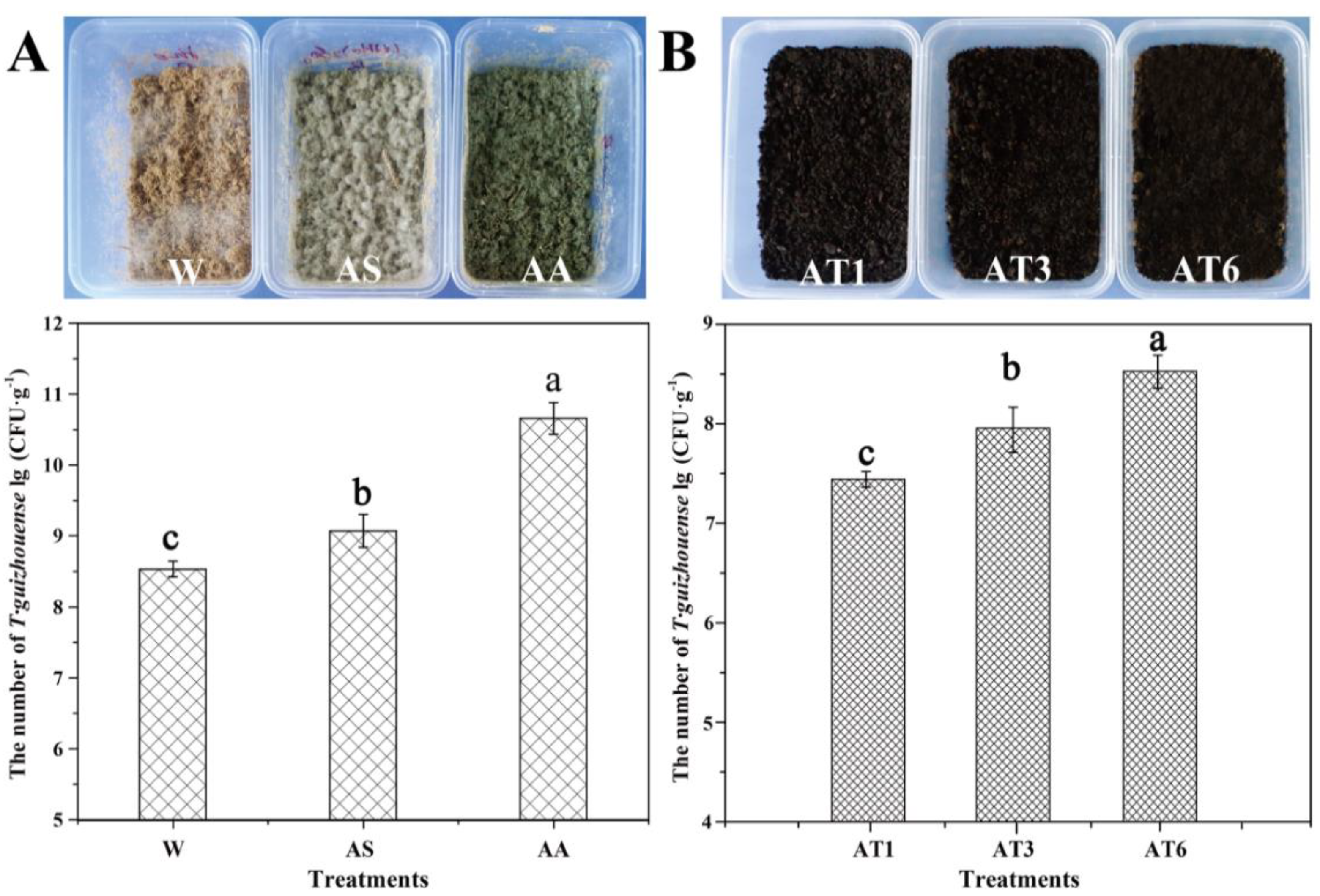
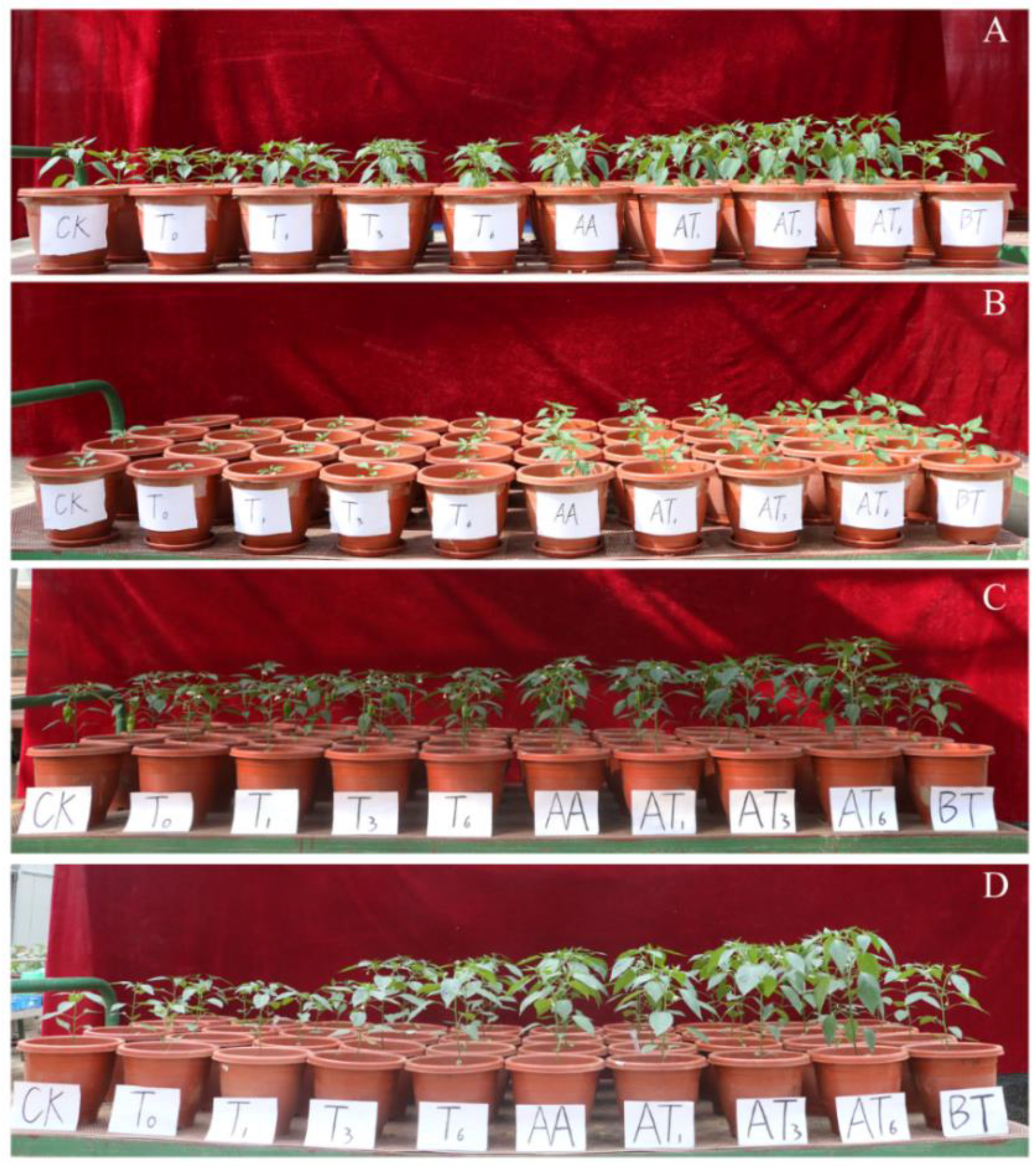
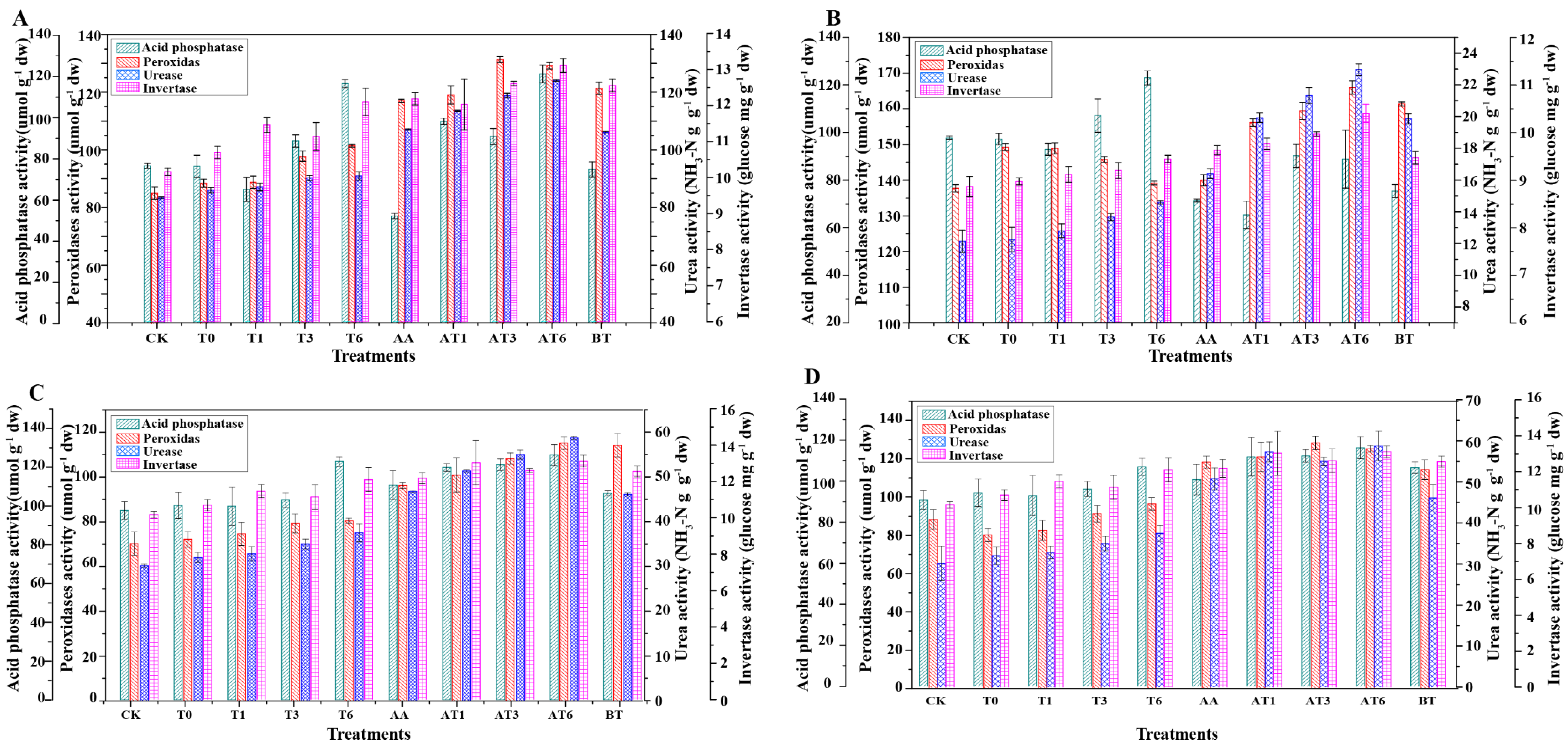
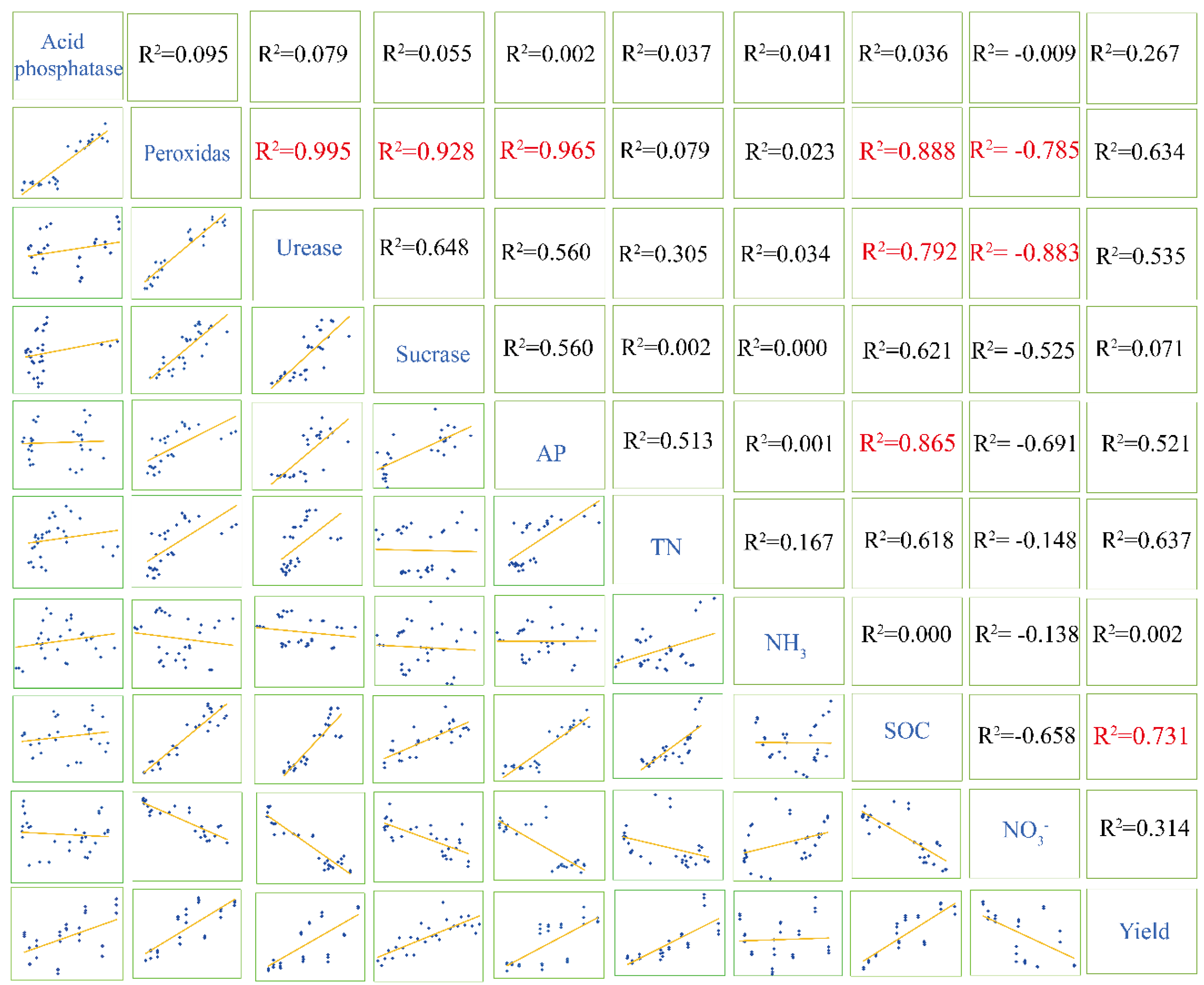
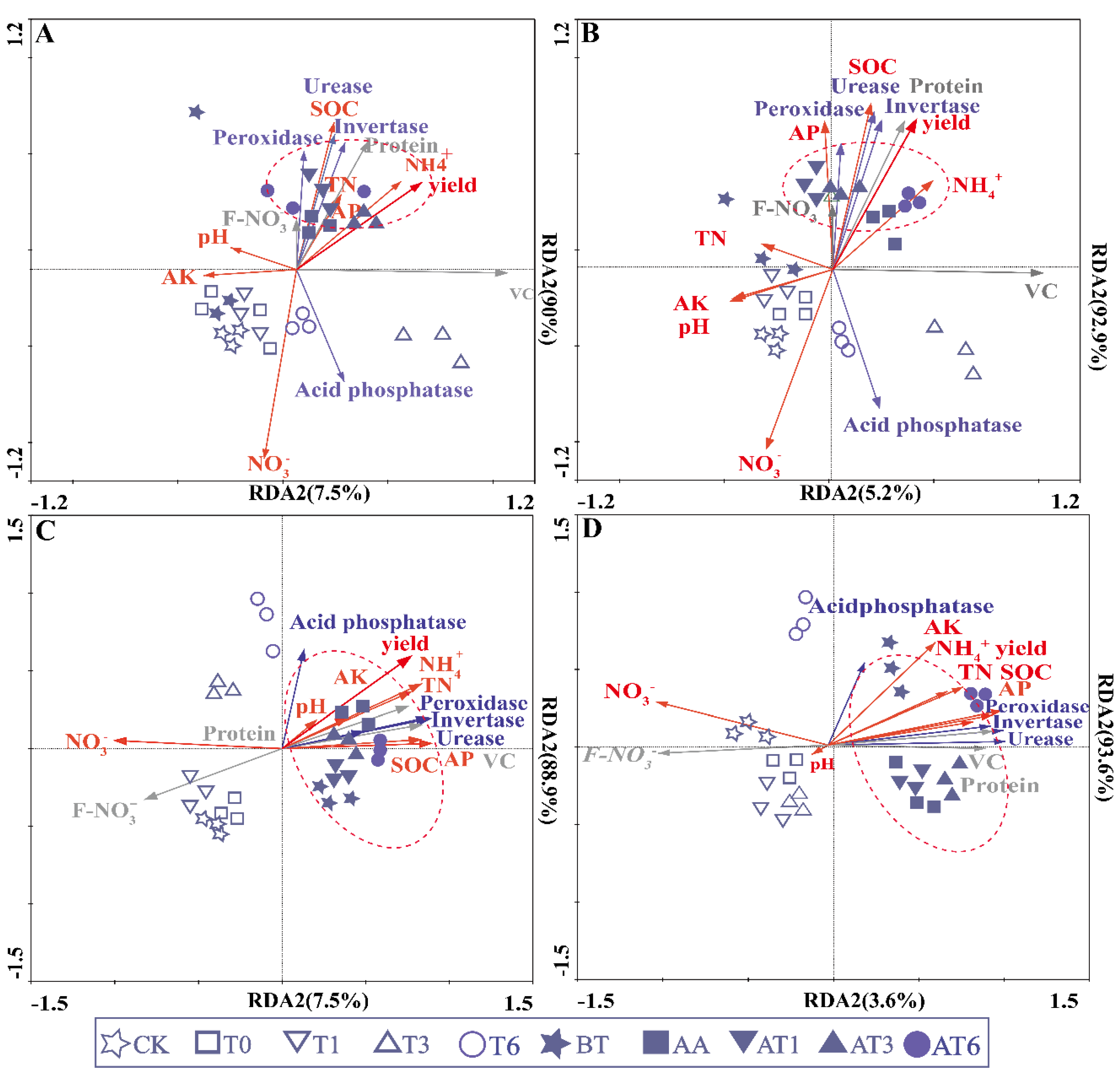
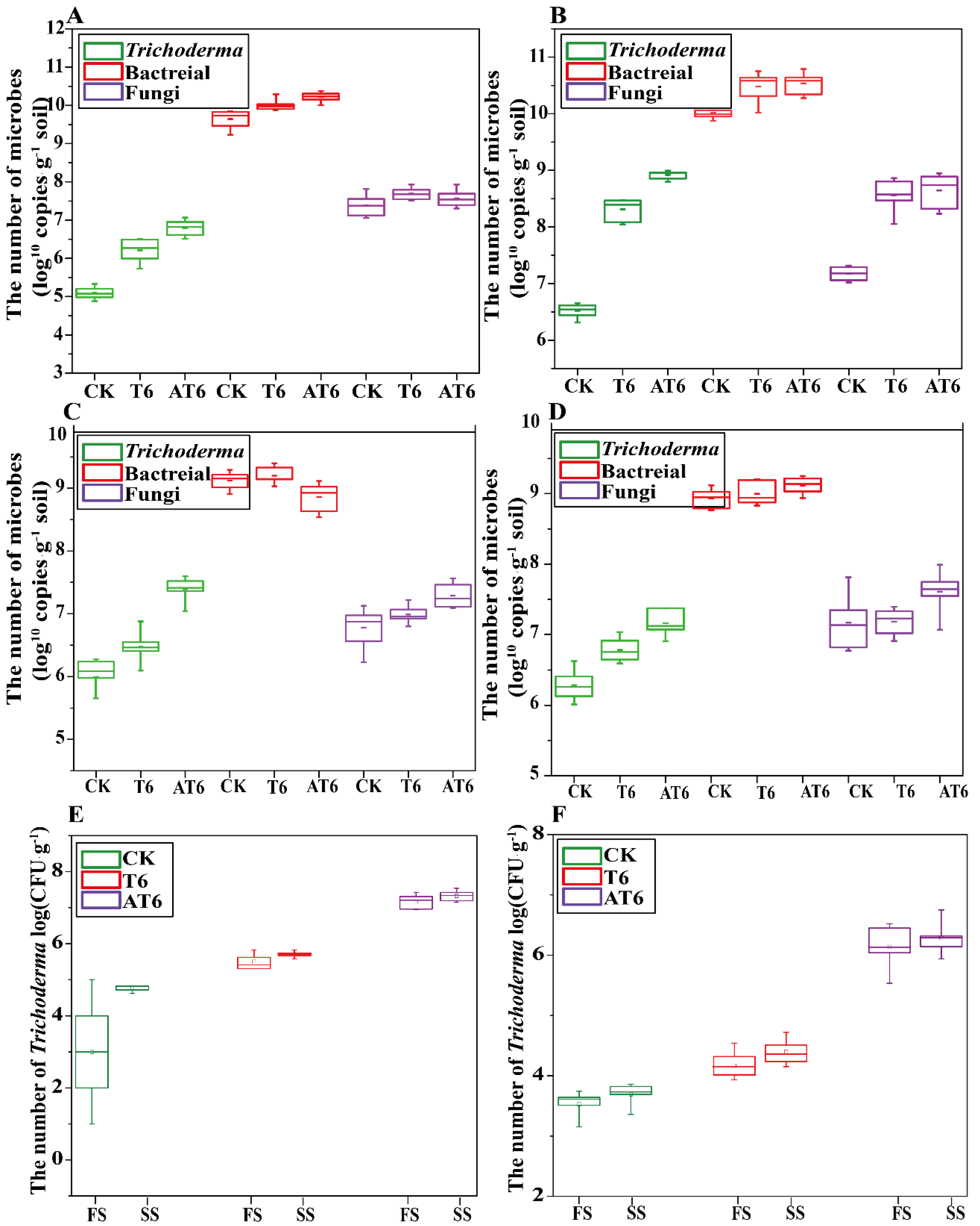
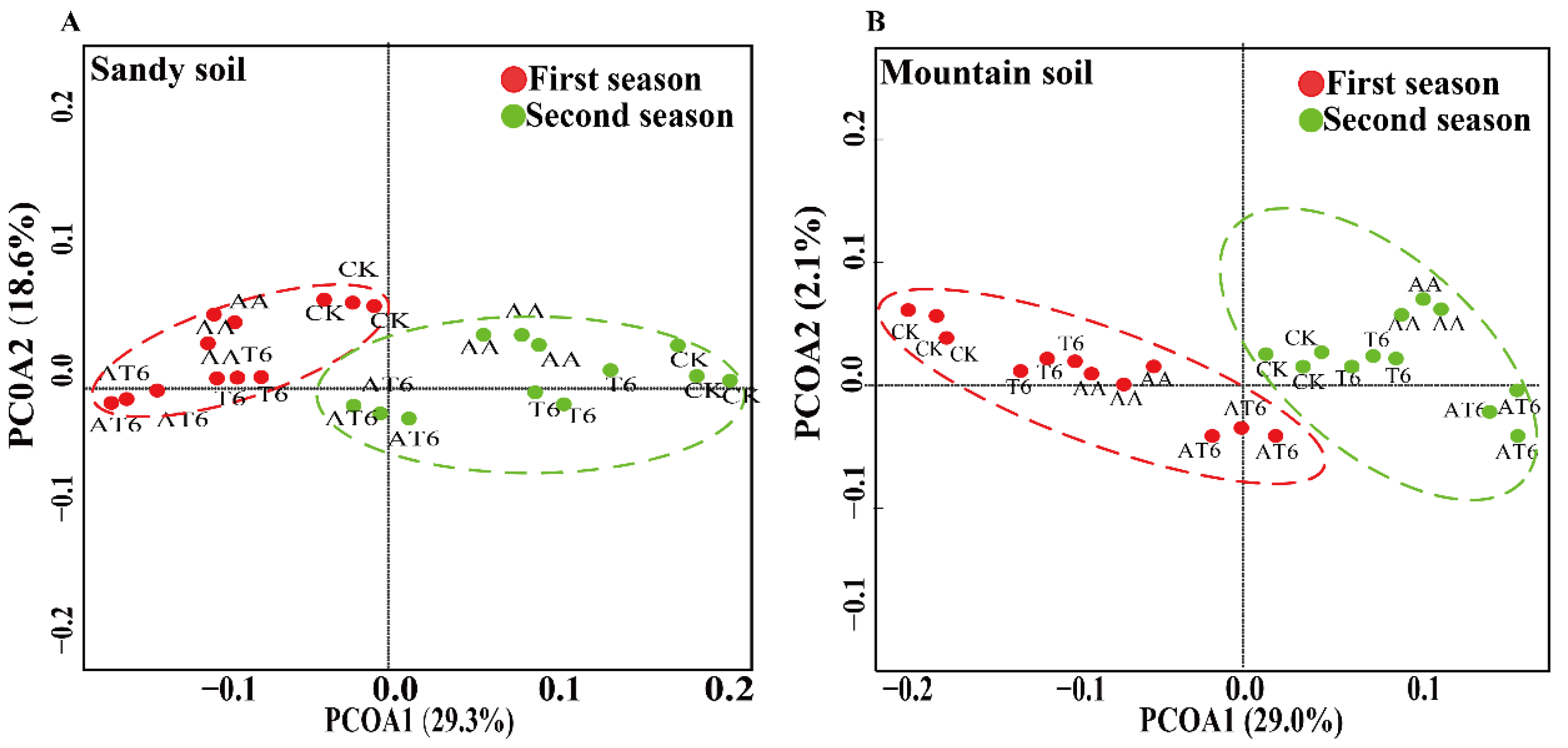
| Treatments | Soil Type | Length (cm) | Diameter (mm) | Yield g·pot−1 | Number Fruit | VC− (mg·kg−1) | NO3− (mg·kg−1) | Protein (g·kg−1) |
|---|---|---|---|---|---|---|---|---|
| CK | Sandy soil | 13.00 | 2.63 | 42.52e ± 8.20 | 3.0c ± 0.32 | 2.33e ± 0.11 | 4.34d ± 0.04 | 55.53d ± 0.25 |
| Mountain soil | 6.36 | 1.53 | 21.11e ± 5.79 | 2.00b ± 0.45 | 1.70f ± 0.02 | 5.30f ± 0.01 | 36.07d ± 1.06 | |
| T0 | Sandy soil | 13.02 | 2.63 | 43.46e ± 12.62 | 3.0ab ± 0.55 | 2.29e ± 0.13 | 4.34d ± 0.01 | 55.38d ± 0.07 |
| Mountain soil | 6.38 | 1.51 | 20.45e ± 4.70 | 2.00b ± 0.32 | 1.66de ± 0.012 | 5.14ef ± 0.02 | 39.21d ± 2.62 | |
| T1 | Sandy soil | 13.62 | 2.80 | 45.02e ± 3.86 | 3.2ab ± 0.37 | 2.38e ± 0.05 | 4.23d ± 0.01 | 56.06d ± 0.14 |
| Mountain soil | 6.44 | 1.52 | 20.01e ± 0.58 | 2.00b ± 0.37 | 1.77cde ± 0.01 | 5.32e ± 0.01 | 37.65d ± 0.31 | |
| T3 | Sandy soil | 15.04 | 2.93 | 50.36cd ± 1.51 | 3.4ab ± 0.25 | 2.58de ± 0.07 | 4.23d ± 0.01 | 57.13cd ± 0.23 |
| Mountain soil | 6.40 | 1.59 | 25.34cd ± 3.84 | 2.00b ± 0.25 | 1.80cd ± 0.04 | 4.89d ± 0.03 | 46.22c ± 0.52 | |
| T6 | Sandy soil | 15.06 | 2.98 | 51.45cd ± 4.32 | 3.4ab ± 0.51 | 2.72d ± 0.03 | 4.22d ± 0.02 | 57.51cd ± 0.06 |
| Mountain soil | 6.46 | 1.61 | 29.09cd ± 4.99 | 2.00b ± 0.51 | 1.89c ± 0.014 | 4.85cd ± 0.08 | 48.48c ± 1.12 | |
| AA | Sandy soil | 16.94 | 3.18 | 55.05bc ± 3.41 | 3.2ab ± 0.20 | 3.14c ± 0.13 | 3.82c ± 0.10 | 60.03c ± 0.46 |
| Mountain soil | 8.34 | 1.79 | 48.72bc ± 3.10 | 3.00a ± 0.37 | 2.10b ± 0.09 | 4.51b ± 0.01 | 52.06b ± 0.15 | |
| AT1 | Sandy soil | 17.02 | 3.19 | 56.29bc ± 6.91 | 3.4a ± 0.25 | 3.14c ± 0.02 | 3.76ab ± 0.05 | 63.91b ± 0.30 |
| Mountain soil | 8.76 | 1.81 | 49.49bc ± 3.05 | 3.00a ± 0.58 | 2.15b ± 0.053 | 4.26a ± 0.07 | 55.74a ± 1.18 | |
| AT3 | Sandy soil | 17.50 | 3.41 | 63.65ab ± 9.23 | 3.8ab ± 0.37 | 3.62ab ± 0.03 | 3.66ab ± 0.01 | 68.39a ± 1.63 |
| Mountain soil | 9.30 | 1.90 | 57.54ab ± 2.79 | 3.00a ± 0.25 | 2.21b ± 0.02 | 4.26a ± 0.15 | 57.01a ± 0.53 | |
| AT6 | Sandy soil | 18.36 | 3.52 | 66.83a ± 4.59 | 4.2a ± 0.37 | 3.79a ± 0.04 | 3.51a ± 0.01 | 68.05a ± 1.48 |
| Mountain soil | 9.40 | 2.11 | 60.04a ± 8.51 | 3.00a ± 0.49 | 2.34a ± 0.10 | 4.10a ± 0.00 | 58.86a ± 1.14 | |
| BT | Sandy soil | 16.22 | 3.11 | 59.61cd ± 3.41 | 3.6 ± ab0.40 | 3.38bc ± 0.19 | 4.08d ± 0.23 | 57.23cd ± 0.61 |
| Mountain soil | 9.12 | 2.02 | 45.08cd ± 2.68 | 3.00a ± 0.63 | 1.77cde ± 0.04 | 4.68bc ± 0.00 | 47.37c ± 1.29 |
| Treatments | First Season | Second Season | ||||||
|---|---|---|---|---|---|---|---|---|
| Sandy Soil | Increasing Rate | Mountain Soil | Increasing Rate | Sandy Soil | Increasing Rate | Mountain Soil | Increasing Rate | |
| CK | 225.63 | - | 124.65 | - | 168.68 | - | 105.57 | - |
| T0 | 253.98 | 12.56% | 117.52 | −5.72% | 186.38 | 10.49% | 102.23 | −3.16% |
| T1 | 259.80 | 15.14% | 140.06 | 12.36% | 175.97 | 4.32% | 109.34 | 3.57% |
| T3 | 299.92 | 32.93% | 164.78 | 32.19% | 219.7 | 30.25% | 118.79 | 12.52% |
| T6 | 320.14 | 41.89% | 174.27 | 39.81% | 256.33 | 51.96% | 160.05 | 51.61% |
| AA | 319.79 | 41.73% | 182.55 | 46.45% | 216.75 | 28.50% | 215.34 | 103.98% |
| AT1 | 304.84 | 35.11% | 180.92 | 45.14% | 228.94 | 35.72% | 202.95 | 92.24% |
| AT3 | 334.98 | 48.46% | 224.13 | 79.81% | 247.4 | 46.67% | 225.12 | 113.24% |
| AT6 | 343.54 | 52.26% | 230.11 | 84.60% | 300.57 | 78.19% | 260.22 | 146.49% |
| BT | 245.67 | 8.88% | 188.34 | 51.10% | 280.18 | 66.10% | 214.97 | 103.63% |
| Treatments | SOC (g·kg−1) | TN (g·kg−1) | NH3+ (mg·kg−1) | NO3− (mg·kg−1) | AP (mg·kg−1) | AK (mg·kg−1) | pH | |
|---|---|---|---|---|---|---|---|---|
| FS | CK | 8.31f ± 0.02 | 8.75cd ± 0.03 | 1.34d ± 0.09 | 297.18a ± 2.16 | 87.58g ± 0.33 | 95.333e ± 1.45 | 7.44 |
| T0 | 8.91e ± 0.08 | 8.78cd ± 0.02 | 1.21d ± 0.07 | 261.95ab ± 8.93 | 87.89fg ± 0.23 | 96.333de ± 4.84 | 7.41 | |
| T1 | 8.93e ± 0.02 | 8.64d ± 0.16 | 1.39d ± 0.11 | 289.30a ± 16.10 | 86.46fg ± 1.61 | 104.33cd ± 1.45 | 7.37 | |
| T3 | 9.15d ± 0.04 | 9.15bc ± 0.10 | 1.89bc ± 0.02 | 278.06a ± 4.42 | 91.5cde ± 0.96 | 109.33bc ± 0.33 | 7.33 | |
| T6 | 9.16d ± 0.11 | 9.31ab ± 0.20 | 2.06ab ± 0.06 | 284.57a ± 7.89 | 96.43ab ± 1.46 | 116.33ab ± 4.25 | 7.32 | |
| AA | 9.46c ± 0.02 | 9.35ab ± 0.21 | 1.82c ± 0.04 | 184.43bc ± 3.50 | 90.24efg ± 2.64 | 106.66c ± 0.67 | 7.39 | |
| AT1 | 9.90b ± 0.06 | 9.52ab ± 0.10 | 2.02bc ± 0.05 | 151.51c ± 4.68 | 95.28abc ± 1.02 | 112.66bc ± 0.88 | 7.40 | |
| AT3 | 9.99b ± 0.07 | 9.37ab ± 0.14 | 2.11ab ± 0.03 | 157.95c ± 5.24 | 96.40ab ± 1.78 | 116.00ab ± 3.00 | 7.35 | |
| AT6 | 10.19a ± 0.09 | 9.66a ± 0.15 | 2.24a ± 0.07 | 140.20c ± 3.81 | 97.98a ± 1.19 | 122.00a ± 4.04 | 7.33 | |
| BT | 10.08f ± 0.04 | 9.48ab ± 0.23 | 1.92bc ± 0.09 | 183.79bc ± 9.93 | 92.81a ± 0.57 | 117.00ab ± 2.52 | 7.32 | |
| SS | CK | 7.34e ± 0.02 | 0.81bc ± 0.01 | 2.39b ± 0.14 | 140.71a ± 1.90 | 7.68b ± 0.28 | 195.66ab ± 7.21 | 7.41 |
| T0 | 7.84d ± 0.02 | 0.78c ± 0.01 | 2.34ef ± 0.08 | 133.04a ± 4.51 | 7.45b ± 0.27 | 185.66bcd ± 7.01 | 7.47 | |
| T1 | 7.60d ± 0.02 | 0.76de ± 0.00 | 2.44d ± 0.22 | 139.59b ± 5.48 | 6.54b ± 0.25 | 180.33bcd ± 4.63 | 7.49 | |
| T3 | 8.31c ± 0.08 | 0.75de ± 0.00 | 2.64e ± 0.41 | 123.93b ± 4.69 | 6.15b ± 0.42 | 168.00e ± 9.17 | 7.53 | |
| T6 | 8.35c ± 0.04 | 0.84b ± 0.01 | 3.09cd ± 0.11 | 108.38c ± 1.60 | 6.91b ± 0.16 | 206.00a ± 1.53 | 7.51 | |
| AA | 9.33b ± 0.23 | 0.79c ± 0.01 | 2.42g ± 0.14 | 32.53d ± 1.22 | 13.06a ± 0.04 | 172.66e ± 1.58 | 7.68 | |
| AT1 | 9.10a ± 0.35 | 0.81de ± 0.01 | 3.40c ± 0.30 | 30.04de ± 1.85 | 14.69a ± 0.62 | 168.00e ± 0.58 | 7.67 | |
| AT3 | 9.86b ± 0.02 | 0.74b ± 0.01 | 4.70f ± 0.09 | 31.27de ± 0.37 | 12.92a ± 0.18 | 179.00abc ± 5.78 | 7.66 | |
| AT6 | 10.04b ± 0.10 | 0.82a ± 0.04 | 4.84ef ± 0.17 | 19.78e ± 0.93 | 11.97a ± 0.13 | 194.3de ± 4.33 | 7.62 | |
| BT | 9.90a ± 0.08 | 1.05bc ± 0.01 | 4.58a ± 0.41 | 95.18c ± 8.83 | 15.06a ± 0.61 | 205a ± 2.08 | 7.67 | |
| Treatments | SOC (g·kg−1) | TN (g·kg−1) | NH3+ (mg·kg−1) | NO3− (mg·kg−1) | AP (mg·kg−1) | AK (mg·kg−1) | pH | |
|---|---|---|---|---|---|---|---|---|
| FS | CK | 7.34e ± 0.02 | 0.84a ± 0.14 | 170.71a ± 1.90 | 0.78de ± 0.00 | 6.01d ± 0.40 | 175de ± 2.08167 | 7.41 |
| T0 | 7.84d ± 0.02 | 0.84a ± 0.08 | 133.04c ± 4.51 | 0.78de ± 0.01 | 6.12d ± 0.09 | 175.6de ± 1.67 | 7.48 | |
| T1 | 7.60de ± 0.02 | 0.85ab ± 0.22 | 139.59c ± 5.48 | 0.76de ± 0.00 | 6.38d ± 0.10 | 177.66d ± 2.85 | 7.49 | |
| T3 | 8.31c ± 0.08 | 0.90b ± 0.17 | 123.93c ± 4.69 | 0.80d ± 0.01 | 5.99d ± 0.29 | 188.00b ± 4.16 | 7.44 | |
| T6 | 8.35c ± 0.04 | 1.07c ± 0.11 | 158.38b ± 1.60 | 0.84c ± 0.01 | 6.91d ± 0.16 | 206.00a ± 1.53 | 7.41 | |
| AA | 8.97b ± 0.12 | 1.57d ± 0.14 | 50.04e ± 10.22 | 0.79d ± 0.00 | 12.02c ± 0.43 | 179.33cd ± 2.33 | 7.47 | |
| AT1 | 9.39a ± 0.06 | 1.64e ± 0.29 | 31.27f ± 1.84 | 0.83bc ± 0.01 | 12.25c ± 0.29 | 174.66de ± 3.18 | 7.47 | |
| AT3 | 9.44a ± 0.02 | 1.74ef ± 0.09 | 19.78f ± 0.37 | 0.89a ± 0.00 | 12.57bc ± 0.17 | 185.66bc ± 2.85 | 7.43 | |
| AT6 | 9.63a ± 0.11 | 1.95f ± 0.17 | 22.53f ± 0.93 | 0.91a ± 0.02 | 13.39a ± 0.21 | 207.66a ± 3.18 | 7.39 | |
| BT | 9.57a ± 0.28 | 1.30cd ± 0.12 | 95.18d ± 8.83 | 0.84b ± 0.02 | 12.06c ± 0.81 | 205.00a ± 2.08 | 7.41 | |
| SS | CK | 8.36d ± 0.18 | 0.79e ± 0.00 | 0.86d ± 0.15 | 324.41a ± 1.90 | 5.58f ± 0.08 | 124.16e ± 1.74 | 7.41 |
| T0 | 8.51cd ± 0.02 | 0.81cd ± 0.00 | 0.85d ± 0.01 | 304.40ab ± 11.26 | 5.43fg ± 0.30 | 126.38e ± 1.47 | 7.47 | |
| T1 | 8.47cd ± 0.06 | 0.80e ± 0.00 | 0.87d ± 0.10 | 289.03b ± 15.35 | 5.87f ± 0.04 | 125.83e ± 1.44 | 7.44 | |
| T3 | 8.65cd ± 0.06 | 0.80b ± 0.02 | 0.95d ± 0.10 | 265.91bc ± 2.44 | 6.21de ± 1.85 | 133.88d ± 2.42 | 7.47 | |
| T6 | 8.62d ± 0.04 | 0.84bc ± 0.01 | 1.05bc ± 0.10 | 219.57d ± 7.88 | 6.25d ± 0.05 | 141.38bc ± 2.00 | 7.44 | |
| AA | 9.51b ± 0.10 | 0.84b ± 0.00 | 1.56c ± 0.11 | 30.37f ± 9.93 | 12.96c ± 0.17 | 138.61cd ± 1.00 | 7.47 | |
| AT1 | 10.02ab ± 0.02 | 0.84ab ± 0.01 | 1.63bc ± 0.11 | 87.62f ± 9.93 | 13.54ab ± 0.13 | 136.94cd ± 1.00 | 7.46 | |
| AT3 | 10.31a ± 0.06 | 0.92b ± 0.00 | 1.78ab ± 0.08 | 83.12f ± 1.40 | 13.69ab ± 1.01 | 145.83b ± 1.73 | 7.42 | |
| AT6 | 10.36a ± 0.04 | 0.94a ± 0.01 | 1.96a ± 0.08 | 81.99g ± 0.98 | 13.88ab ± 0.89 | 157.72a ± 1.95 | 7.48 | |
| BT | 9.37bc ± 0.12 | 0.94a ± 0.01 | 1.32d ± 0.05 | 114.12e ± 2.78 | 13.09a ± 0.42 | 136.38cd ± 5.05 | 7.45 | |
© 2020 by the authors. Licensee MDPI, Basel, Switzerland. This article is an open access article distributed under the terms and conditions of the Creative Commons Attribution (CC BY) license (http://creativecommons.org/licenses/by/4.0/).
Share and Cite
Liu, Q.; Meng, X.; Li, T.; Raza, W.; Liu, D.; Shen, Q. The Growth Promotion of Peppers (Capsicum annuum L.) by Trichoderma guizhouense NJAU4742-Based Biological Organic Fertilizer: Possible Role of Increasing Nutrient Availabilities. Microorganisms 2020, 8, 1296. https://doi.org/10.3390/microorganisms8091296
Liu Q, Meng X, Li T, Raza W, Liu D, Shen Q. The Growth Promotion of Peppers (Capsicum annuum L.) by Trichoderma guizhouense NJAU4742-Based Biological Organic Fertilizer: Possible Role of Increasing Nutrient Availabilities. Microorganisms. 2020; 8(9):1296. https://doi.org/10.3390/microorganisms8091296
Chicago/Turabian StyleLiu, Qiumei, Xiaohui Meng, Tuo Li, Waseem Raza, Dongyang Liu, and Qirong Shen. 2020. "The Growth Promotion of Peppers (Capsicum annuum L.) by Trichoderma guizhouense NJAU4742-Based Biological Organic Fertilizer: Possible Role of Increasing Nutrient Availabilities" Microorganisms 8, no. 9: 1296. https://doi.org/10.3390/microorganisms8091296
APA StyleLiu, Q., Meng, X., Li, T., Raza, W., Liu, D., & Shen, Q. (2020). The Growth Promotion of Peppers (Capsicum annuum L.) by Trichoderma guizhouense NJAU4742-Based Biological Organic Fertilizer: Possible Role of Increasing Nutrient Availabilities. Microorganisms, 8(9), 1296. https://doi.org/10.3390/microorganisms8091296






